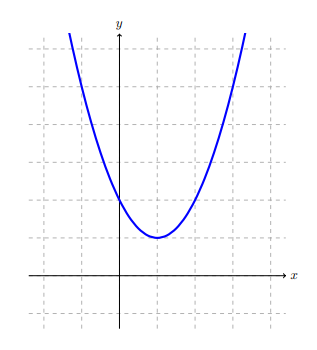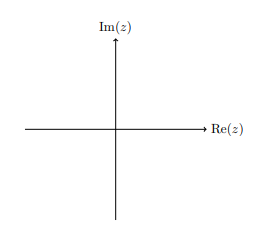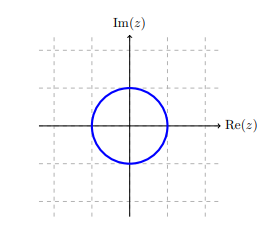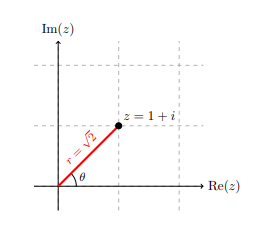Supplemental Videos
The main topics of this section are also presented in the following videos:
The main topics of this section are also presented in the following videos:
All the mathematical work you have done so far has involved using real numbers. In this section, we will work with a new set of numbers called the complex numbers. It should be noted that the real numbers are actually a special case of the complex numbers. This will be explained in more detail later in this section.
Let's start by providing some background as to where complex numbers arise from. Suppose that we want to solve for the \(x\)-intercepts of \(f(x) = x^2 -2x + 2\text{.}\) We can use the quadratic formula to obtain the \(x\)-intercepts, and when doing so, we obtain the following expression:
Notice that \(\sqrt{-4}\) is not a real number because there are no real numbers whose square is negative. As a result, \(f(x) = x^2 -2x + 2\) has no real \(x\)-intercepts. We can also verify this graphically since the graph of \(f(x) = x^2 - 2x + 2\) never crosses the \(x\)-axis.

Even though the square root of a negative number is not a real number, there are many instances when we would like to be able to use it (e.g., finding the solutions to \(x^2-2x+2 = 0\)). So, we need to define a new set of numbers that are not real numbers.
An imaginary number is of the form
where \(a > 0\) is a real number and \(i\) is an imaginary unit. Here, \(i\) is defined as \(i = \sqrt{-1}\) or \(i^2 = -1\text{.}\)
Unless stated otherwise, the letter \(i\) is used to represent a constant, not a variable!
Let's refer back to the motivational example introduced earlier in this section. The value \(\sqrt{-4}\) can be expressed as follows:
Recall that when solving for the \(x\)-intercepts of \(f(x) = x^2 -2x + 2\text{,}\) we obtained the following values for \(x\) with the quadratic formula:
Using our new established knowledge of imaginary numbers, we find that
which implies that \(x = 1 + i\) or \(x = 1 - i\text{.}\) These \(x\)-values are examples of complex numbers.
A complex number is of the form
where \(a\) and \(b\) are real numbers. Here, \(a\) is called the real part and \(b\) is called the imaginary part.
From this definition, we can observe that all real numbers are actually complex numbers with imaginary part equal to \(0\text{.}\) Moreover, imaginary numbers are actually complex numbers with real part equal to \(0\text{;}\) these numbers are called pure imaginary numbers
The real and imaginary parts of a complex number can never be combined. Here is a result that tells us when two complex numbers are equal.
Two complex numbers \(z = a+bi\) and \(w = c+di\) are equal if and only if \(a = c\) and \(b = d\text{.}\)
Like real numbers, we can add, subtract, multiply, and divide complex numbers.
Consider two complex number \(z = a+bi\) and \(w = c+di\text{.}\) Then their sum is given by
and their difference is given by
Compute \((4+5i) + (8-6i)\) and \((2-3i) - (5+2i)\text{.}\)
Solutionand
When taking the product of two complex numbers, you should always remember that
Finding the product of two pure imaginary numbers is relatively straightforward.
Consider two pure imaginary numbers \(z = ai\) and \(w = bi\text{.}\) Then their product is given by
Finding the product of two complex numbers is slightly different since we need to use the distributive property.
Consider two complex numbers \(z = a+bi\) and \(w = c+di\text{.}\) Then their product is given by
Compute \((3i)(4i)\) and \((2+3i)(-3-2i)\text{.}\)
Solutionand
WARNING: The following property is true with real numbers, but it is not true with complex numbers:
Here is a counter-example: let \(a = b = -2\text{.}\) Then,
but
Hence,
(especially when \(a\text{,}\) \(b\) are both negative).
Finding the quotient of two complex numbers requires us to use the technique of rationalizing the denominator. We will consider two different types of quotients: division by a pure imaginary number and division by a complex number.
Consider a complex number \(z = a+bi\) and a pure imaginary number \(w = ci\text{.}\) Then,
When dividing by a complex number, we rationalize the denominator by multiplying the complex conjugate.
For any complex number \(z = a + bi\text{,}\) the number
is called the complex conjugate of \(z\text{.}\)
The product of a complex number and its conjugate is a real number. That is,
Consider two complex numbers \(z = a+bi\) and \(w = c + di\text{.}\) Then,
Compute \(\frac{8+9i}{2i}\) and \(\frac{4-2i}{2+3i}\text{.}\)
Solutionand
Like real numbers, we can also graph complex numbers. In order to plot a complex number, we will utilize a plane called the complex plane. The complex plane has two axes: a horizontal axis (which we will call the real axis) to plot the real part, and a vertical axis (which we will call the imaginary axis) to plot the imaginary part. In addition, the point where the real and imaginary axes cross is called the origin, and it is denoted by \((0,0)\text{.}\)

To plot a complex number \(z = a + bi\text{,}\) we move \(a\) units in the horizontal direction and then we move \(b\) units in the vertical direction. Here, \(\text{Re}(z) = a\) and \(\text{Im}(z) = b\text{.}\)
Plot the complex numbers \(2+4i\text{,}\) \(-2+6i\text{,}\) and \(-3-i\) in the complex plane
SolutionTo plot \(2+4i\text{,}\) we move \(2\) units to the right from the origin, and then we move \(4\) units up. To plot \(-2+6i\text{,}\) we move \(2\) units to the left from the origin, and then we move \(6\) units up. To plot \(-3-i\text{,}\) we move \(3\) units to the left from the origin, and then we move \(1\) unit down.

Whenever we plot a complex number \(z = a + bi\text{,}\) we sometimes use the notation \((a,b)\) to denote a point in the complex plane. In this context, \((a,b)\) represents a single complex number whose real part is \(a\) and imaginary part is \(b\text{.}\)
The modulus of a complex number \(z = a + bi\) is given by
Observe that \(|z| \geq 0\text{.}\)
Compute the modulus of \(z = 3 + 4i\) and \(w = -1 + i\text{.}\)
SolutionIf \(z = 3+4i\text{,}\) then \(a=3\) and \(b=4\text{.}\) Hence,
Similarly, if \(w=-1+i\text{,}\) then \(a=-1\) and \(b = 1\text{.}\) Hence,
Plot all points in the complex plane that satisfy the equation \(|z| = 1\text{.}\)
SolutionThe points in the complex plane that satisfy the equation \(|z| = 1\) all have a distance of \(1\) unit from the origin. This means that all these points lie on a circle of radius \(1\) centered at the origin.

Now that we have familiarized ourselves with complex numbers, we are ready to make some connections to trigonometry. In the previous subsection, we talked about how to plot a complex number \(z = a+bi\) as a point \((a,b)\) in the complex plane. Moreover, we talked about how the point \((a,b)\) has a distance of \(|z|=\sqrt{a^2+b^2}\) from the origin. We can use our knowledge of polar coordinates to express a complex number in terms of the trigonometric functions \(\sin(\theta)\) and \(\cos(\theta)\text{.}\) Recall that when converting a Cartesian coordinate \((x,y)\) to a polar coordinate \((r,\theta)\text{,}\) we used the following formulas:
The process of finding the polar form of a complex number is analogous. Let's consider a motivational example. Suppose that we have the complex number \(z = 1 + i\text{.}\) We can plot \(z\) as follows in the complex plane.

For convenience, put \(r = |z|\text{.}\) Observe that the ray drawn from the origin to the point \((1,1)\) makes an angle \(\theta\) from the real axis. Then, we can use right triangle trigonometry to write \(a\) and \(b\) as follows:
and
Since \(\tan(\theta) = 1\) and \(a\text{,}\) \(b > 0\text{,}\) the unit circle tells us that \(\theta = \frac{\pi}{4}\text{.}\) This means that
and
Putting things together, the polar form of \(z = 1 + i\) is given by
The complex number \(z = a+bi\) in polar form is given by
Here, \(r = \sqrt{a^2+b^2}\text{,}\) \(a = r\cos(\theta)\text{,}\) \(b = r\sin(\theta)\text{,}\) and \(\tan(\theta) = \frac{b}{a}\) (assuming that \(a \neq 0\)). Moreover, \(0 \leq \theta \le 2\pi\) is called the argument of the complex number and \(r\) is its modulus.
A key reason for working with complex numbers in polar form is that it makes computing the product and quotient of complex numbers more manageable.
If \(z = r(\cos(\alpha)+i\sin(\alpha))\) and \(w = R(\cos(\beta)+i\sin(\beta))\text{,}\) then
Observe that the formula for computing the product of two complex numbers in polar form requires us to simply multiply their moduli and add their arguments. Here's a quick verification of how to obtain the formula for the product using the sum identities for sine and cosine:
Use polar form to compute the product of \(z=1+i\) and \(w =-1-i\text{.}\)
SolutionYou should verify that \(z = \sqrt{2}(\cos(\frac{\pi}{4}) + i\sin(\frac{\pi}{4}))\) and \(w = \sqrt{2}(\cos(\frac{5\pi}{4})+i\sin(\frac{5\pi}{4}))\text{.}\) Then,
If \(z = r(\cos(\alpha)+i\sin(\alpha))\) and \(w = R(\cos(\beta)+i\sin(\beta))\text{,}\) then
Use polar form to compute the quotient of \(z=1+i\) and \(w =-1-i\text{.}\)
SolutionYou should verify that \(z = \sqrt{2}(\cos(\frac{\pi}{4}) + i\sin(\frac{\pi}{4}))\) and \(w = \sqrt{2}(\cos(\frac{5\pi}{4})+i\sin(\frac{5\pi}{4}))\text{.}\) Then,
We can also use polar form to compute the powers and roots of a complex number with feasibility. For example, if \(z = r(\cos(\theta)+i\sin(\theta))\text{,}\) then using the double-angle formulas we find that
Hence,
In general, for any positive integer \(n\text{,}\) a complex number raised to the \(n\)-th power is given by the following theorem.
If \(z = r(\cos(\theta)+i\sin(\theta))\) is a complex number in polar form and \(n\) is a positive integer, then
Let \(z = \sqrt{3}+i\text{.}\) Compute \(z^4\text{.}\)
SolutionYou should verify that \(z = 2\big(\cos(\frac{\pi}{6}) + i\sin(\frac{\pi}{6})\big)\text{.}\) Using De Moivre's Theorem, we find that
A complex number \(z = r(\cos(\theta)+i\sin(\theta))\) in polar form has \(n\) complex \(n\)-th roots given by
where \(k = 0\text{,}\) \(1\text{,}\) \(2\text{,}\) ..., \(n-1\text{.}\)
Find the square roots of \(z = i\text{.}\)
SolutionYou should verify that \(z = \sin(\frac{\pi}{2})i\text{,}\) \(\theta = \frac{\pi}{2}\text{,}\) \(r = 1\text{.}\) and \(n = 2\text{.}\) Then,
and
Hence, the square roots of \(z=i\) are given by \(\pm \frac{1}{\sqrt{2}}(1+i)\text{.}\)